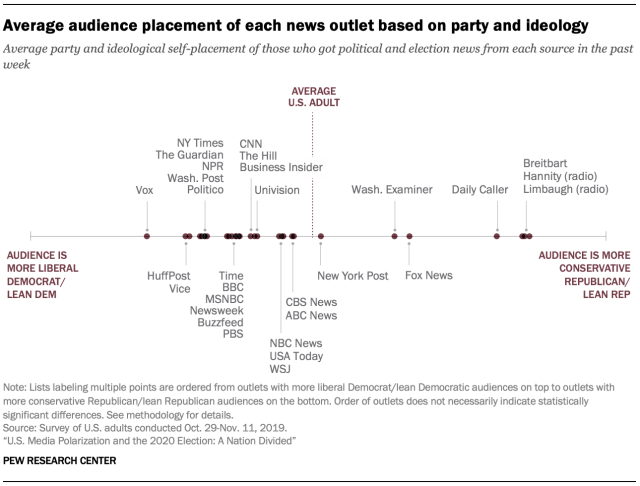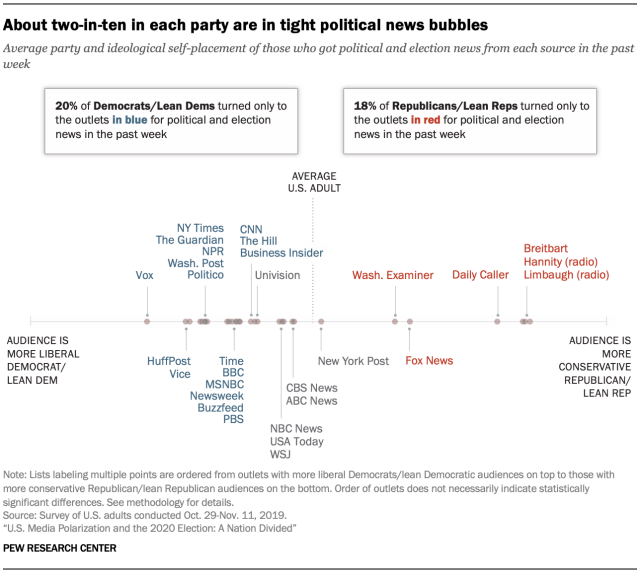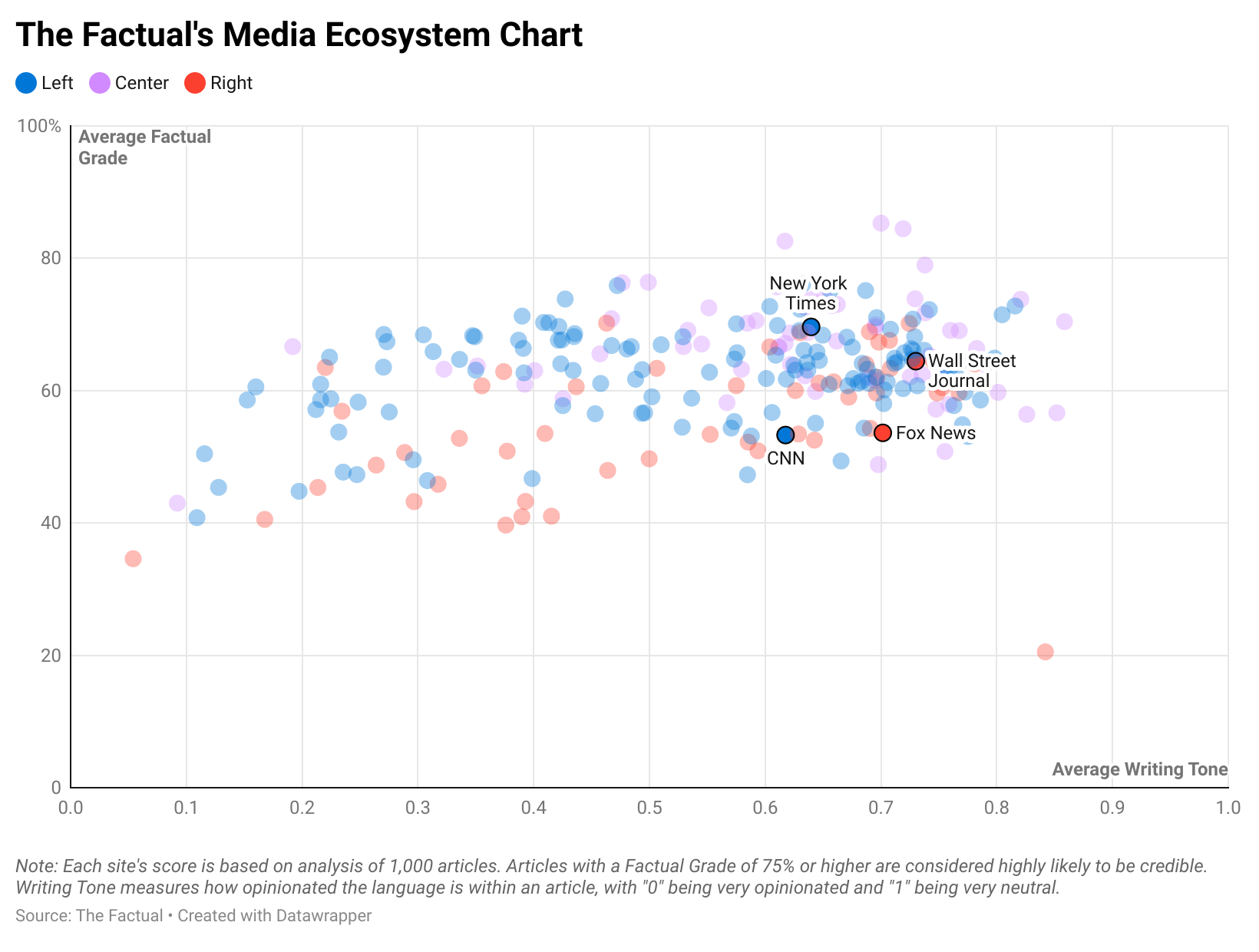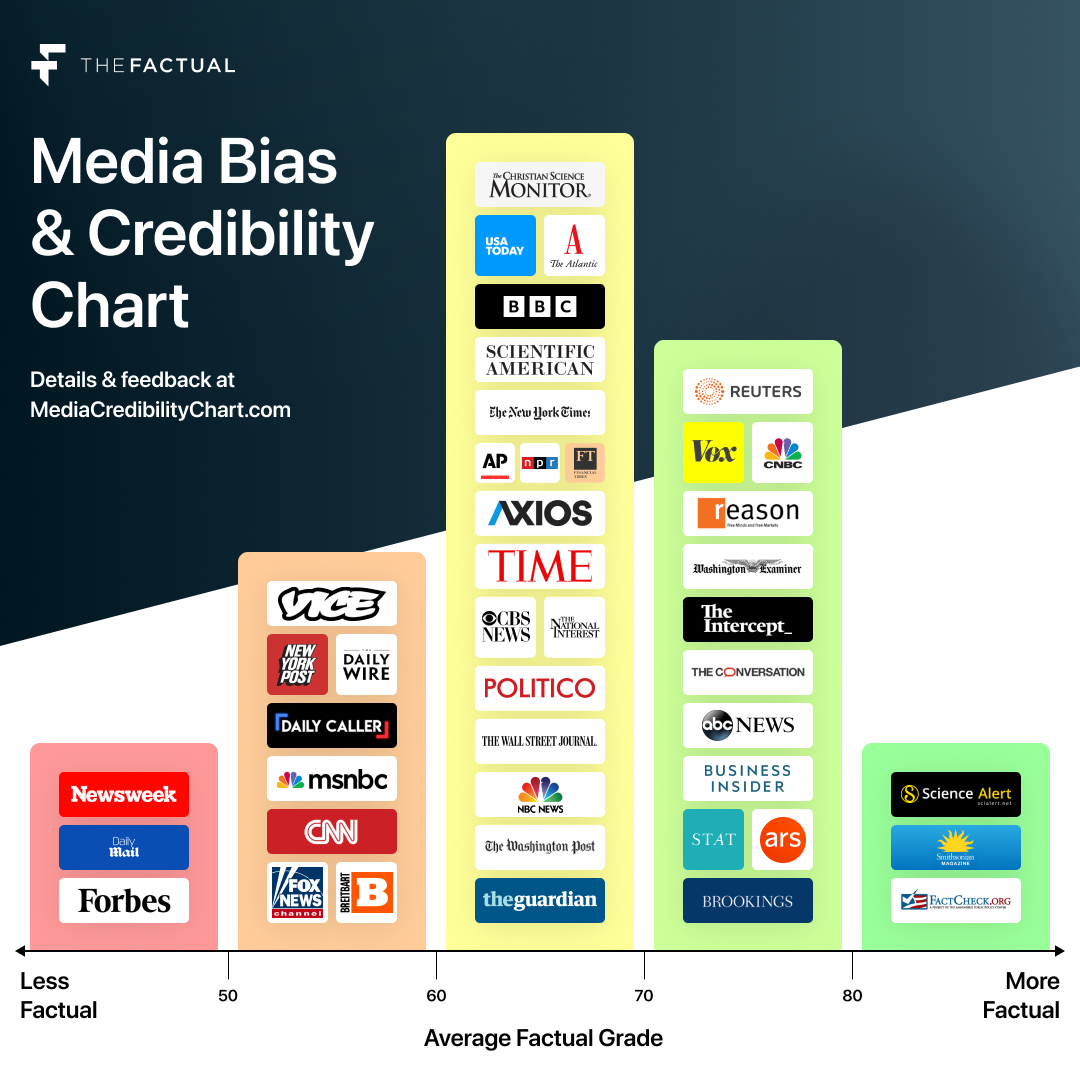The Factual helps people find unbiased news on trending topics. Our transparent rating system uncovers the most informative and least opinionated stories from hundreds of sources across the political spectrum. Sign up for our daily newsletter or download our app (Apple or Android) today!
In an increasingly polarized news space, we often seek the goldilocks zone of nonpartisan news. Some sources may strike us as too liberal, others as too conservative, while all we’re looking for is the perfect, middle-ground combination. If you’re here to find out what those sources may be, you’ve come to the right place.
Please check your email for instructions to ensure that the newsletter arrives in your inbox tomorrow.

This chart demonstrates self-assigned political leanings of news readers.
As we are saturated with news options, data shows that emotive content gets clicks, resulting in more partisanship, bias, and sensationalism. What incentive do news sources have to remain centrist?
There are a few organizations whose mission is to craft news as devoid of political bias as possible. Often these sources take the form of wire services, like Associated Press and Reuters, which are trusted by news outlets across the political spectrum to publish straightforward, factual news. This minimally biased approach to reporting stands in contrast to major news sites like Fox News and MSNBC. Studies by organizations like Pew Research help document this growing gap in Americans’ trust in different news sources.
How Do Centrist News Sources Succeed?
One method is by creating content that is then interpreted by other sources with political leanings. Newswires like Reuters and the Associated Press maintain huge networks of journalists to provide breaking news coverage the world over. Elsewhere, centrist sources also commonly avoid carrying advertisements, especially concerning politics, and instead focus on creating quality content free of external influence. In fact, one way to find quality sources is to follow the funding: sources that don’t rely on an ad-based revenue model have the ability to put out highly credible, objective news since they are not at the mercy of the companies they feature. A famous parallel can be seen in Elon Musk’s stance on marketing, and his focus on creating a quality product rather than convincing audiences to buy it.
The Top 3 Centrist News Outlets Based on Average Factual Grade:
- FactCheck.org
- FactCheck.org is consistently the highest-scoring news outlet according to The Factual’s news-rating algorithm. FactCheck.org regularly weighs in on controversial news topics by providing excellently researched articles to separate fact from fiction.
- Top article: “A Guide to Pfizer/BioNTech’s Pediatric COVID-19 Vaccine for Kids 5-11” (99%)
- FactCheck.org is consistently the highest-scoring news outlet according to The Factual’s news-rating algorithm. FactCheck.org regularly weighs in on controversial news topics by providing excellently researched articles to separate fact from fiction.
- The Conversation
- The Conversation is not-for-profit news organization that publish articles written by academics and researchers.
- Top article: “Bitcoin is now ‘legal tender’ in El Salvador – here’s what that means” (96%)
- The Conversation is not-for-profit news organization that publish articles written by academics and researchers.
- Reuters
- An independent international news organization that also contains a financial data reporting sector.
Should We Read Centrist Source and Ignore Everything Else?
Of course not! Many sources have some degree of political bias and a target audience, but that does not stop them from publishing well-researched, reliable news content. When conveyed with minimal bias and ample evidence, articles from across the political spectrum can help inform and challenge our beliefs. The danger is in solely relying on a specific source or perspective to inform our understanding.
For example, I was talking to a friend recently who told me that they rely on the New York Times and NPR for all of their information. They would never trust anything that came from Breitbart or Fox News. Prior to my time at The Factual, I would probably say the same. But The Factual’s work consistently shows how valuable news stories come from across the political spectrum. Reading too narrowly can lead to ignorance on specific issues, a lack of awareness about the range of perspectives, and an inability to bring people and ideas into a conversation.
Loyalty to one narrative can inhibit us from receiving the best news out there, and in such a saturated news space, there is no reason to read anything but the very best. And even if we hate to admit it, sometimes the highest-quality article is from a source whose political leaning differs from our own.
 This chart takes the previous audience-determined news leaning chart and models which sources people refer to by party.
This chart takes the previous audience-determined news leaning chart and models which sources people refer to by party.How Should I Pick What to Read?
Audiences should come to terms with the fact that credible articles can emerge from organizations that may exhibit some political bias. This means that we need to separate our individual bias toward certain publications and instead consider the articles as standalone works. Source quality is just one of the four factors we’ve identified to impact an article’s Factual Grade, along with diversity of cited sources, author expertise, and writing tone. This means that articles from expert authors that reference diverse sources in a neutral tone can come from a range of left- or right-leaning sources as disparate as CNN and Fox News. We must take care not to dismiss an article before reading it.
To start your search, here are some high-scoring left- and right-leaning publications for high-volume, general news content:
Left-leaning:
- Vox
- Vox is a news site founded by Ezra Klein that focuses on explaining the news. Articles pay special attention to providing readers with context for the latest news stories.
- Top article: “Pesticides can amplify each other. Bees have become the victims.” (91%)
- Vox is a news site founded by Ezra Klein that focuses on explaining the news. Articles pay special attention to providing readers with context for the latest news stories.
- ABC News
- ABC News is one of the biggest names in news and our algorithm shows that their articles regularly publish high-quality, well-researched news.
- Top article: “With Texas abortion law, out-of-state clinics expect surge of patients” (91%)
- ABC News is one of the biggest names in news and our algorithm shows that their articles regularly publish high-quality, well-researched news.
- CNBC
- Perhaps best known for its television presence, the business news network CNBC also has a large and growing online presence.
- Top article: “Why California is shutting down its last nuclear plant” (91%)
- Perhaps best known for its television presence, the business news network CNBC also has a large and growing online presence.
Right-leaning:
- Reason
- Reason is an American libertarian magazine, published monthly. They sport the motto “Free minds and free markets.”
- Top article: “20 States Sue Over Title IX Guidance on Gender Identity” (91%)
- Reason is an American libertarian magazine, published monthly. They sport the motto “Free minds and free markets.”
- Washington Examiner
- The Washington Examiner is a news site positioned as a conservative alternative to the Washington Post and focuses largley on the latest news in the nation’s capital.
- Top article: “Blue cities forge ahead with their own police reforms” (89%)
- The Washington Examiner is a news site positioned as a conservative alternative to the Washington Post and focuses largley on the latest news in the nation’s capital.
- Wall Street Journal
- WSJ is a New York-based newspaper with coverage of general news and especially business and finance.
- Top article: “Deaths Raise Safety Concerns Around Gene Therapy” (83%)
- WSJ is a New York-based newspaper with coverage of general news and especially business and finance.
Topical Publications
While the above publications are strong for a baseline understanding of concepts, they often lack the expertise of some smaller, more niche publications. Since the cost of media distribution has gone down, these sites have flourished by covering more niche topics extensively, creating unique analysis and content that general news sources lack. Thanks to this expertise and rigor, these special-interest publications often have the highest credibility according to our algorithm. We often feature these as long-reads in our newsletter because they provide readers with a contextual analysis of an issue at large. Here are some of the highest-rated, special-interest publications.
- Foreign Affairs: Brookings Institution
- Brookings is widely regarded as one of the world’s largest and most impactful think tanks and routinely publishes incisive articles on foreign affairs.
- Top article: “What does the Federal Reserve mean when it talks about tapering?” (90%)
- Brookings is widely regarded as one of the world’s largest and most impactful think tanks and routinely publishes incisive articles on foreign affairs.
- Science: ScienceAlert
- ScienceAlert is science news site and aggregator that routinely publishes high-quality news about scientific discoveries and debates.
- Top article: “In All of Human History, Have Any Societies Truly Lived Underground?” (96%)
- ScienceAlert is science news site and aggregator that routinely publishes high-quality news about scientific discoveries and debates.
- Technology: Ars Technica
- Ars Technica publishes news, reviews, and guides on computer hardware and software, science, technology policy, and video games.
- Top article: “Nvidia now lets “RTX Voice” noise cancellation run on GTX-level cards” (91%)
- Ars Technica publishes news, reviews, and guides on computer hardware and software, science, technology policy, and video games.
- Culture: Smithsonian Magazine
- The Smithsonian Magazine is owned and published by the Smithsonian Institution, which supports scholarship in science, history, and the arts.
- Top article: “Eight-Foot-Tall, 1,600-Year-Old Statue of Pagan Deity Found in Ireland” (99%)
- The Smithsonian Magazine is owned and published by the Smithsonian Institution, which supports scholarship in science, history, and the arts.
Please check your email for instructions to ensure that the newsletter arrives in your inbox tomorrow.
Conclusion
Sifting through the massive amount of information published from not only nonpartisan sources, but those with leanings and specializations, can be very time consuming. The Factual’s newsletter curates the most credible news from a variety of general sources and supplements them with highly-ranked specialist publications. In the process, we often find our own biases challenged but never fail to promote articles from sources with ideas different from our own. By doing so, we are able to say, with confidence, that we are reading the best news.
Cover image from Rene Rader.
Article updated April 1, 2022 to reflect new data.




